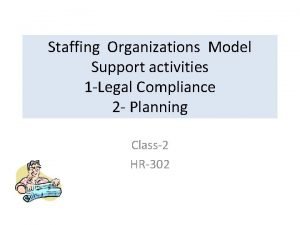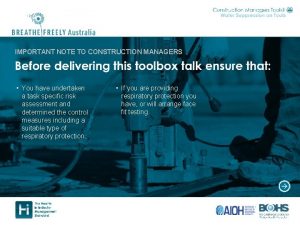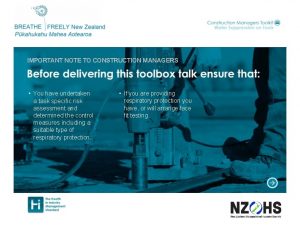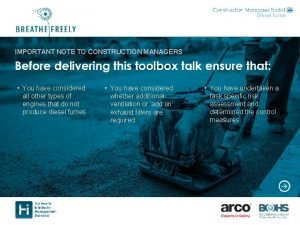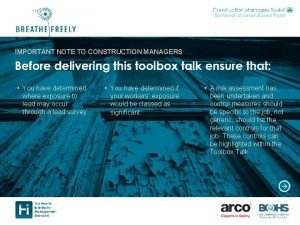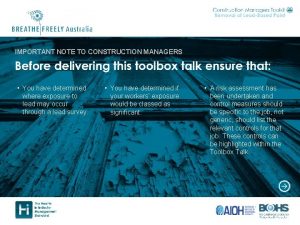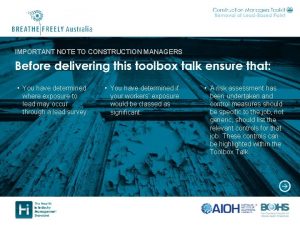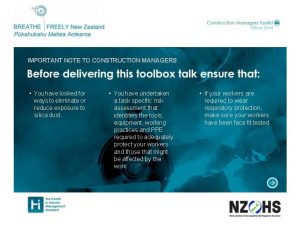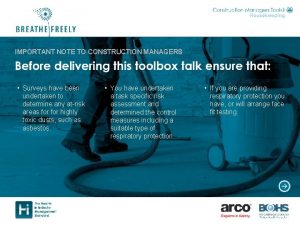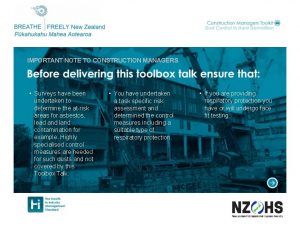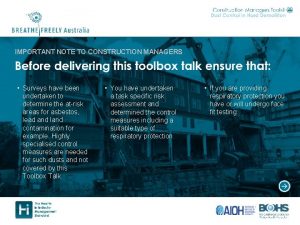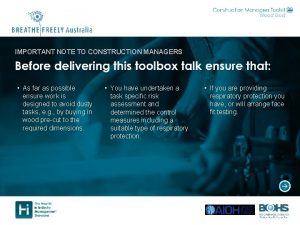IMPORTANT NOTE TO CONSTRUCTION MANAGERS You have undertaken












- Slides: 12

IMPORTANT NOTE TO CONSTRUCTION MANAGERS • You have undertaken a task specific risk assessment and determined the control measures including a suitable type of respiratory protection. • If you are providing respiratory protection you have, or will arrange face fit testing.


Stones, rocks, sands and clays are all used to make products such as kerbs, flags, bricks, tiles, mortar and concrete. However, these materials contain large amounts of crystalline silica that can seriously damage your lungs. Bad practice picture required Fine silica dust, also known as respirable crystalline silica (RCS), can be created when cutting, grinding, drilling, sanding and polishing these silica-containing materials. If the dust from these processes are not properly controlled, they can cause occupational diseases such as: • Lung cancer • Silicosis • Chronic obstructive pulmonary disease, such as chronic bronchitis and emphysema (similar to the illnesses that occur through smoking)

We can supply you with the risk assessment for grinding, polishing, drilling, sanding and cutting activities and train you to use the correct control measures. Good practice picture required One highly effective way to reducing exposure to dusts during these activities is to supply a tool which is fitted with a water supply so that the dust is dampened down or supressed. This will prevent the dust from reaching your lungs. (The other common method to control exposure is local exhaust ventilation (LEV) and again, the vacuum extractor can be fitted to the tool itself. )

Water suppression systems fitted to tools usually involve spraying water directly onto the material. The water spray is supplied via mains water supply or a pressurised water bottle. There needs to be an adequate supply of water so make sure you have this before you start. Pouring from a container before you start will not be sufficient. It is important to note that on-tool water suppression might not reduce exposure enough, in which case we will supply you with respiratory protective equipment (RPE) as well. This will be: • of a suitable standard. • face fit tested to ensure it fits you. • included with training to ensure you understand how to use it.

We will develop a safe system of work and train you so that you are aware of when wet dust suppression is not suitable and introduces other hazards, for example: • Wet dust suppression should not be used on saws that are electronically operated – they are suitable for tools powered by combustion engines or compressed air. • Using a saw fitted with a water suppression system and fed by a backpack water tank can present a slipping hazard due to the weight of the backpack and the water. • The addition of extraction hoses or water tanks can make tools heavier and more difficult to use and so we should consider manual handling in designing safe systems. • Using water creates slurry that can stain/will dry out. You will need to account for this and try to cut in dedicated areas or cut in a tray to catch the slurry, hosing down areas etc.

• Use the tool and water suppression attachments as you have been trained to do so. • Use other PPE provided for the job, such as waterproof trousers or leggings etc. • Make sure no one around you is affected by any dust or flying debris being generated. Use any screens or other physical barriers provided. • Maintain an adequate water flow by cleaning and maintaining the water jets regularly, at least every time the blades are changed. • Make sure that water hoses and bottles are in good condition and undamaged.

1 Why does my tool come with a water attachment? 2 What are the main health effects of uncontrolled exposure to silica dusts? 3 Do you have everything you need to protect yourself at work? Harmful silica dusts can be created by cutting, grinding, sanding and polishing products such as kerbs, flags, tiles, mortar and concrete. We can dampen down or suppress this dust by fitting tools with a water supply attachment. • Lung cancer. • Read and understand the risk assessment. • Silicosis. • Chronic obstructive pulmonary disease, such as chronic bronchitis and emphysema. • Always use the tool with its water supply attachment. • Check and look after your PPE. • Inform workers around you if you are undertaking dust generating tasks so that they can protect themselves.


Visual standards demonstrate ‘what good looks like’. They are intended to reinforce expectations of health and safety standards.

• Certain tools (never electric ones) have attachments which are connected to a water supply in order to dampen down harmful dust at source. • Respirators (dust masks) of suitable standard are also worn for work which involves cutting, grinding, sanding and polishing silica-containing materials. • Respirators are fitted and maintained so that they are suitable for individual workers and in good condition.

Current titles in the Let’s Talk series Diesel Fume Dust Control in Hard Demolition Dust Control in Soft Strip Demolition Housekeeping Painting with Brushes and Rollers Removal of Lead-Based Paint Silica Water Suppression on Tools Welding Fume Wood Dust www. breathefreelyaustralia. org. au
 The crusades were military expeditions undertaken by
The crusades were military expeditions undertaken by The crusades were military expeditions undertaken by
The crusades were military expeditions undertaken by What activities are undertaken in staffing
What activities are undertaken in staffing Department strategy
Department strategy It is not you they are rejecting but me
It is not you they are rejecting but me Difference between note making and note taking
Difference between note making and note taking Note making and note taking difference
Note making and note taking difference Difference between note making and note taking
Difference between note making and note taking Financial documents in order
Financial documents in order What is debit note
What is debit note What is debit note and credit note
What is debit note and credit note Note making advantages
Note making advantages Simple discount rate
Simple discount rate


